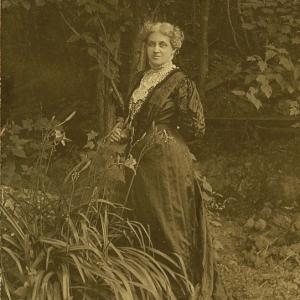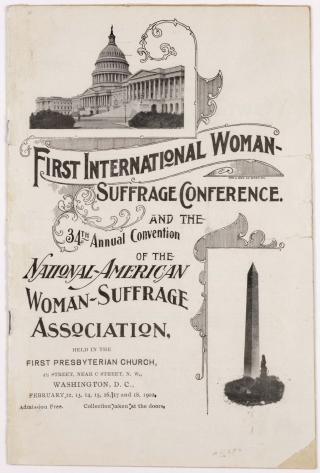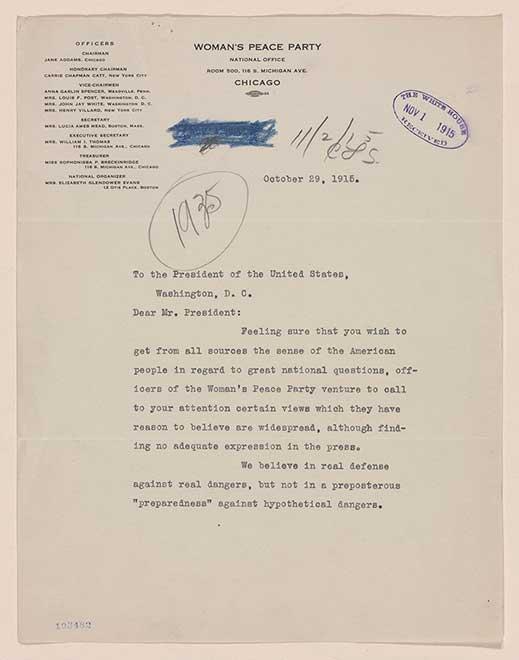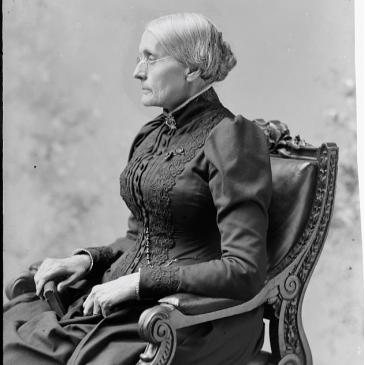Carrie Chapman Catt

Carrie Chapman Catt was a leading figure in the women's suffrage movement, known for her instrumental role in securing the passage of the 19th Amendment, granting American women the right to vote.
Carrie Chapman Catt founded the League of Women Voters in 1920 to support newly enfranchised women and promote civic engagement.
She was an advocate for international peace and women’s rights, co-founding the International Alliance of Women, which focused on advancing gender equality worldwide.
“This world taught woman nothing skillful and then said her work was valueless. It permitted her no opinions and said she did not know how to think. It forbade her to speak in public and said the sex had no orators,”
Presidential Address to National American Woman Suffrage Association, February 12, 1902
Carrie Clinton Lane Chapman Catt, a masterful political strategist, suffragist, and peace activist, played a pivotal role in securing the right to vote for American women. As the leader of the National American Woman Suffrage Association (NAWSA) and the founder of the League of Women Voters in 1920 to bring women into the political mainstream, she worked tirelessly for White women to have equal voting rights.
A Seed is Planted: Early Life and Education
Carrie Chapman Catt was born on January 9, 1859, in Ripon, Wisconsin, to Maria Clinton and Lucius Lane, who were farmers originally from Potsdam, New York. She grew up as the second of three children. When she was seven, her family moved to Charles City, Iowa, where Catt attended preparatory school. At age 13, she witnessed her parents publicly supporting Horace Greeley in the 1872 presidential election, at that moment exposed her to the glaring gender inequities in voting and sparked her interest in social justice.
Although Catt was known to be a private woman, even as a child, her peers recognized her to be self-confident and well-liked by people throughout her life. Catt attended Iowa State Agricultural College (now Iowa State University) and earned a degree in general science. She broke barriers during her time at the college by becoming the first female student to deliver an oration before a college debating society and establishing military drills for women as a form of exercise. While pursuing her education, Catt supported herself by working as a dishwasher, teacher, and librarian’s assistant. When she graduated in 1880, she was the only woman in her class.

Above: Portrait of Carrie Chapman Catt from her college graduation in 1880.
Catt, Carrie Chapman. Carrie Chapman Catt Papers: Miscellany; Photographs Image 52. - 1920, 1890. Manuscript/Mixed Material. loc.gov/item/mss154040574
Finding Her Voice: Early Career and Personal Tragedy
After graduating, Catt took on roles as a law clerk, schoolteacher, and later as a principal in Mason City, Iowa. At the age of 24, she became one of the first women in the United States to serve as a superintendent of schools.
In 1885, Catt married newspaper editor Leo Chapman who supported her advocacy interests. The couple became co-editors at the Mason City Republican newspaper where Catt started “Woman’s World”, a segment in the paper. The column focused on advocating for women’s suffrage and provided a platform to discuss social reform, gender equity, and the role of women in society. Tragically, Leo died of typhoid fever just a year after their marriage. Widowed and seeking new opportunities, Catt moved to San Francisco, where she became the city’s first female newspaper reporter. While working at the newspaper, she experienced sexual harassment from the editor. This inappropriate behavior made her realize both the inequality she faced and how commonplace sexual harassment was in the workplace (Catt Center).
Stepping Into the Movement: Advocacy Begins
In 1887, Catt returned to Iowa and joined the suffrage movement by becoming a member of the Iowa Woman Suffrage Association. She took on roles such as writing, lecturing, and eventually serving as the Association’s secretary and state organizer.
In 1890, Catt married George Catt, a wealthy engineer and fellow Iowa State alumnus. George’s unwavering support—both financial and personal—enabled Catt to dedicate herself fully to the suffrage cause. That same year, she joined the National American Woman Suffrage Association (NAWSA) and quickly gained national recognition for her compelling speeches and ability to mobilize local suffrage chapters across the country. Through the NAWSA, Catt also worked alongside Elizabeth Cady Stanton and Julia Ward Howe.
Catt focused her efforts on securing state-level voting rights and campaigned to win suffrage for women in South Dakota in 1890 (National Parks Service). Although the initiative failed, she remained steadfast in her mission. Catt and her husband relocated to Boston in 1892 due to George’s work. His work earned him more wealth and provided more networking opportunities for the couple.
Catt served in various roles within the NAWSA, including head of field organizing, where she crossed paths with her mentor, Susan B. Anthony. As momentum grew for the Black vote, the NAWSA started separating itself from efforts in support of Black women voting rights. In 1900, she succeeded Anthony as NAWSA president. During this time, Catt also played a key role in helping secure the passage of women’s suffrage in Colorado in 1893.
Expanding the Fight: International Leadership

Above: The program from the First International Women Suffrage Conference published February 12-18, 1902
First International Woman Suffrage Conference and the 34th Annual Convention of the National American Woman Suffrage Association, Washington, D. C. February 12-18, 1902. Online Text. loc.gov/item/rbcmiller001399
Recognizing the international dimensions of the suffrage issue, in 1902, Catt cofounded the International Woman Suffrage Alliance (IWSA) to spread democracy around the globe. The main principles of the organization emphasize that men and women are inherently equal in intelligence, ability, and individual rights, and that denying women their rights—particularly the right to vote—creates social, legal, and economic injustices that harm society as a whole. The first meeting was hosted in Washington, D.C., where women from eleven different countries united (Woman Alliance). During the meeting, delegates strategized and advocated for women’s suffrage on a global scale, shared resources, and supported each other’s campaigns. The second meeting was hosted in Berlin, officially deeming the IWSA an international organization. The IWSA eventually went on to have supportive organizations from thirty-two nations and is still active today, under the new name, International Alliance of Women. In 1904, she retired briefly to care for her dying husband, who passed away a year later. That loss, combined with those of her brother, mother, and activist Susan B. Anthony, left her emotionally drained. Grieving, Catt spent several years traveling abroad and serving as president of the International Woman Suffrage Alliance. However, due to the development of World War I, the organization went on a temporary hiatus.

Above: An image of a typescript letter written by the WPP to US President Thomas Woodrow Wilson about the WPP's stances.
Woman’s Peace Party to the President of the United States, October 29, 1915. Typescript letter. Woodrow Wilson Papers. Manuscript Division, Library of Congress. Accessed January 23, 2025. loc.gov/exhibitions/world-war-i-american-experiences/about-this-exhibition/arguing-over-war/for-or-against-war/advocating-for-peace
Angry about the U.S.’s involvement with World War I, Catt and Jane Addams hosted a conference to discuss pacifism and women’s rights in Washington, D.C. This gathering served as the roots for establishing the Woman’s Peace Party (WPP) in 1915. The WPP was, “one of the most prominent organizations opposing the preparedness movement and American military intervention,” during World War I (Library of Congress). WPP members served as delegates to the International Congress of Women in the Netherlands. There, alongside feminist peace activists from nations involved in World War I, they advanced an agenda that emphasized international cooperation, women’s right to choose their governments, mediation to end armed conflicts, and disarmament. As the women’s pacifist movement expanded its global focus, the WPP became the U.S. branch of the Women’s International League for Peace and Freedom (WILPF). After World War I, the group remained dedicated to global disarmament, gathering 6 million signatures for a petition presented at the League of Nations’ World Disarmament Conference in 1932. Throughout the 20th century, the WILPF continued its efforts to promote peace and advance women’s rights worldwide (Gale).
Leadership During the Final Push for Suffrage

Above: Carrie Chapman Catt carries a US flag while walking the in New York Suffrage Parade in late October of 1915
Catt, Carrie Chapman. Carrie Chapman Catt Papers: Miscellany; Photographs. - 1920, 1890. Manuscript/Mixed Material. loc.gov/item/mss154040574
Catt reluctantly resumed the NAWSA presidency in 1915 to 1920. While on her sabbatical, Anna Howard Shaw led the NAWSA, which was causing an internal divide amongst the group (LOC). While Shaw spoke against racism, she was in opposition to racial equality and the voting right of women of color or immigrants (Oregon Secretary of State). A year later, Catt developed the “Winning Plan,” which aligned state suffrage campaigns with the push for a constitutional amendment, leading to the eventual success of the 19th Amendment. The plan focused on securing the federal amendment while also promoting state and local efforts. Catt used a multi-level strategy, campaigning for the amendment in supportive states, organizing at the state level where possible, and focusing on local initiatives in less receptive areas. She prioritized collaboration among suffrage groups, believing all efforts were essential for ratification (Bill of Rights Institute).
Meanwhile, Catt faced strategic challenges from younger recruits such as Alice Paul and Lucy Burns, who favored militant tactics and focused exclusively on a U.S. constitutional amendment. Unlike Catt and other suffragists who employed peaceful, lawful methods such as lobbying and state-by-state campaigns, Paul and Burns embraced the militant approaches of suffragettes in Britain, including public protests and civil disobedience. Catt also differed with Paul and Burns over picketing the White House during World War I; Catt supported Wilson’s war effort and continued her state-by-state suffrage campaigns. Paul eventually broke away from the NAWSA to form the National Women’s Party (NWP). While Paul never publicly spoke out against Catt, she privately encouraged women to be loyal only to the NWP. While both leaders attempted to find common ground multiple times, they were not able to rekindle a working relationship. Catt once angrily proclaiming, “I will fight you to the last ditch!” while exiting a verbal altercation (NPS).
Through Catt’s leadership, the NAWSA earned the support for the amendment’s ratification from Congress and individual states. Catt consolidated New York City suffrage groups into the Woman Suffrage Party, greatly contributing to the New York state suffrage victory in 1917 after previous failed attempts. While Catt was not a vocal supporter of White supremacy and even spoke at Black/African American churches and clubs, she sometimes leveraged societal prejudices to rally support for White women’s suffrage, often at the expense of women of color. While in the south in 1917, noting that her audience thought of women’s suffrage as a threat against White Supremacy, she wrote that “white supremacy would be strengthened, not weakened, by woman suffrage” while editing a guide for suffrage workers (National Park Service).
In 1920, on the final year of Catt’s leadership, the suffrage amendment (the 19th) became part of the US Constitution.
Beyond Suffrage: Lasting Legacy

Above: Carrie Chapman Catt is honored in Turkey for her international efforts by being placed on a Turkish stamp.
Catt, Carrie Chapman. Carrie Chapman Catt Papers: Subject File, -1950; Turkish stamp honoring Catt. - 1950, 1848. Manuscript/Mixed Material. loc.gov/item/mss154040523
With the passage of the 19th Amendment in 1920, Catt founded the League of Women Voters (LWV) to educate women on political issues, serving as the organization’s honorary president until her death in 1947.
In 1921, she became the first woman to deliver a commencement address at her alma mater. She urged graduated to “be men and women of vision”. She famously concluded the speech with, “To the wrongs that need resistance, to the right that needs assistance, to the future in the distance, give yourselves” (Catt Center).
Two years later, she published, alongside Nettie Rogers Shuler, Woman Suffrage and Politics: The Inner Story of the Suffrage Movement. The 133-page book explores why women in twenty-six other countries gained the right to vote before women in the United States. The authors attribute the delay to opposition from the liquor lobby (Library of Congress). Much of the liquor industry believed that granting women the right to vote would lead to the passage of Prohibition laws, which would negatively impacting their businesses. This prompted them to use their political influence to block suffrage efforts.
In addition to her efforts for women’s rights, Catt also dedicated her time to other causes, such as child labor and world peace. After the horrors of World War I, she co-founded, alongside Jane Addams, the Committee on the Cause and Cure of War in 1925. The following year, Time Magazine featured Catt on its cover in 1926, recognizing her lifelong work. Catt also received awards for her international efforts (the Pictorial Review Award in 1930, the American Hebrew Medal in 1933, and the Chi Omega Award at the White House in 1941). Catt died in her childhood home in New Rochelle, New York at 88 years old from heart failure. The Carrie Chapman Catt House was indited into the National Register of Historic Places in 2006 and is open for visitors to walk through and experience.
Even after her death, Catt’s contributions continue to be recognized worldwide. She was inducted into the National Woman’s Hall of Fame (1982), and Iowa State University founded the Carrie Chapman Catt Center for Women and Politics (1992) and renovated and renamed a hall in her honor (1995). In 2020, the LWV marked its 100th year of activity providing voter education, registration, and advancing advocacy efforts.
 Primary Source Analysis Strategies
Primary Source Analysis Strategies
Analyzing Photographs & Prints
Class Picture
Caption: A portrait of Carrie Chapman Catt from her college graduation in 1880.
Primary source inquiry
- What details in the photograph (e.g., clothing, setting, or posture) suggest the cultural or social norms for women during this period?
- How do you think Catt’s education influenced her perspectives on gender equality and social reform?
- What does this photograph reveal about the significance of higher education for women in the 1880s?
Educator Notes
- Educators can use Teacher’s Guide: Analyzing Photographs & Prints to guide learner inquiry.
Analyzing Primary Sources
Woman’s Peace Party Letter
Caption: An image of a typescript letter written by the WPP to US President Thomas Woodrow Wilson about the WPP’s stances.
Primary source inquiry
- How does this letter reflect broader societal attitudes toward war and peace during World War I?
- What role did the Woman's Peace Party play in the broader pacifist movement during this period?
- What values or principles does the WPP emphasize in their arguments for peace, and how do these align with feminist ideals of the time?
- What might the formal and professional format of the typescript letter suggest about the WPP's strategy to be taken seriously in a male-dominated political sphere?
Educator Notes
- Educators can use Teacher’s Guide: Analyzing Primary Sources guide learner inquiry.
Analyzing Books and Other Printed Texts
“Woman suffrage and politics: The Inner story of the suffrage movement”
Caption: Carrie Chapman Catt's Woman Suffrage and Politics: The Inner Story of the Suffrage Movement chronicles the strategic efforts, challenges, and triumphs of the women’s suffrage movement in the United States, culminating in the passage of the 19th Amendment.
Primary source inquiry
- How does the book reflect the political and social attitudes of its time, and how might its perspective differ from a modern analysis of the suffrage movement?
- Were there any disagreements or challenges between the people in the suffrage movement, and how did they handle those differences?
- What were some of the ways women worked together to win the right to vote, and which ones seemed to work the best?
Educator Notes
- Educators can use Teacher’s Guide: Analyzing Books & Other Printed Texts to guide learner inquiry.
 Carry the Torch
Carry the Torch
- Bill of Rights Institute. “Carrie Chapman Catt: The Woman of the Hour and Purpose, Handout A: Narrative.” Bill of Rights Institute Resources. Accessed January 23, 2025. https://billofrightsinstitute.org/activities/carrie-chapman-catt-the-woman-of-the-hour-and-purpose-handout-a-narrative.
- Catt, Carrie Chapman. "Commencement Address, June 15, 1921." Carrie Chapman Catt Center for Women and Politics, Iowa State University. Accessed January 27, 2025. https://awpc.cattcenter.iastate.edu/2017/03/21/commencement-address-june-151921/.
- First International Woman Suffrage Conference and the 34th Annual Convention of the National American Woman Suffrage Association, Washington, D. C. February 12-18, 1902. Online Text. https://www.loc.gov/item/rbcmiller001399/.
- Gale. “Peace Studies and the Anti-War Movement.” Women’s Studies Archive: Resources on Peace Studies. Accessed January 23, 2025. https://www.gale.com/primary-sources/womens-studies/collections/peace-studies-and-the-anti-war-movement.
- Iowa State University. “Carrie Chapman Catt.” Carrie Chapman Catt Center for Women and Politics. Accessed January 23, 2025. https://cattcenter.iastate.edu/home/about-us/carrie-chapman-catt/.
- Iowa State University. “The Crisis, 1917.” Carrie Chapman Catt Center for Women and Politics. Accessed January 23, 2025. https://iastate.app.box.com/v/TheCrisis-1917.
- Library of Congress. “Advocating for Peace.” World War I: American Experiences Exhibition. Accessed January 23, 2025. https://www.loc.gov/exhibitions/world-war-i-american-experiences/about-this-exhibition/arguing-over-war/for-or-against-war/advocating-for-peace/.
- Library of Congress. “Carrie Chapman Catt.” National American Woman Suffrage Association Collection. Accessed January 23, 2025. https://www.loc.gov/collections/national-american-woman-suffrage-association/articles-and-essays/carrie-chapman-catt/.
- Woman Suffrage by Federal Constitutional Amendment: Hearings before the Committee on Woman Suffrage, United States Senate, Sixty-Fifth Congress, First Session on S. J. Res. 8, May 23, 1917. Washington, D.C.: Government Printing Office, 1917. Accessed January 23, 2025. https://www.loc.gov/item/27006874/.
- National Park Service. “Did You Know? Alice Paul and Carrie Catt.” National Park Service Articles. Last modified February 28, 2022. https://www.nps.gov/articles/dyk-alice-paul-carrie-catt.htm.
- National Park Service. “To the Wrongs That Need Resistance: Carrie Chapman Catt’s Lifelong Fight for Women’s Suffrage.” National Park Service Articles. Last modified January 10, 2023. https://www.nps.gov/articles/000/to-the-wrongs-that-need-resistance-carrie-chapman-catt-s-lifelong-fight-for-women-s-suffrage.htm.
- Opheim, T., (1981) “The Woman's World: Carrie Lane Chapman in the Mason City Republican”, The Palimpsest 62(5), 130-139. doi: https://doi.org/10.17077/0031-0360.22690
- Oregon Secretary of State. “Anna Howard Shaw.” Oregon Women’s Suffrage Exhibit. Accessed January 23, 2025. https://sos.oregon.gov/archives/exhibits/suffrage/Pages/bio/shaw.aspx.
- UK Parliament. “The International Women’s Suffrage Alliance.” Living Heritage: Elections and Voting. Accessed January 23, 2025. https://www.parliament.uk/about/living-heritage/transformingsociety/electionsvoting/womenvote/case-studies-women-parliament/what-difference/suffrage-societies-response/the-international-womens-suffrage-alliance/.
- Citation for image: Carrie Chapman Catt. , . N. D. Photograph. https://www.loc.gov/item/rbcmiller002725/.
- Citation for quote: Catt, Carrie Chapman. “Presidential Address to the National American Woman Suffrage Association, February 12, 1902.” Archives of Women’s Political Communication. Carrie Chapman Catt Center for Women and Politics, Iowa State University. Accessed January 23, 2025. https://awpc.cattcenter.iastate.edu/2018/05/04/presidential-address-to-nawsa-xxx-xx-1902/.
MLA – Robledo-Allen Yamamoto, Asami. “Carrie Chapman Catt.” National Women’s History Museum, 2025. Date accessed.
Chicago – Robledo-Allen Yamamoto, Asami. “Carrie Chapman Catt.” National Women’s History Museum. 2025, https://www.womenshistory.org/education-resources/biographies/carrie-chapman-catt
Susan B. Anthony

This biography is sponsored in part by the Library of Congress Teaching with Primary Sources Eastern Region Program, coordinated by Waynesburg University. Content created and featured in partnership with the TPS program does not indicate an endorsement by the Library of Congress.
For further information or questions, please contact [email protected].






